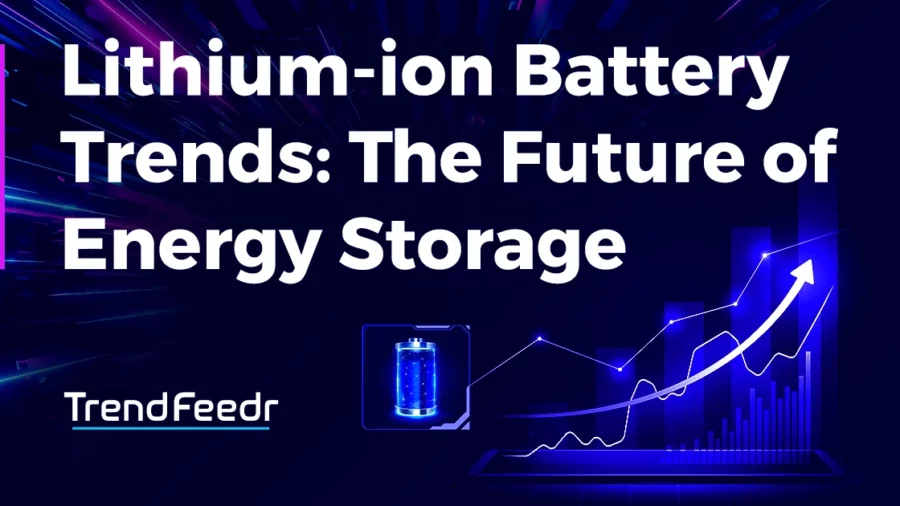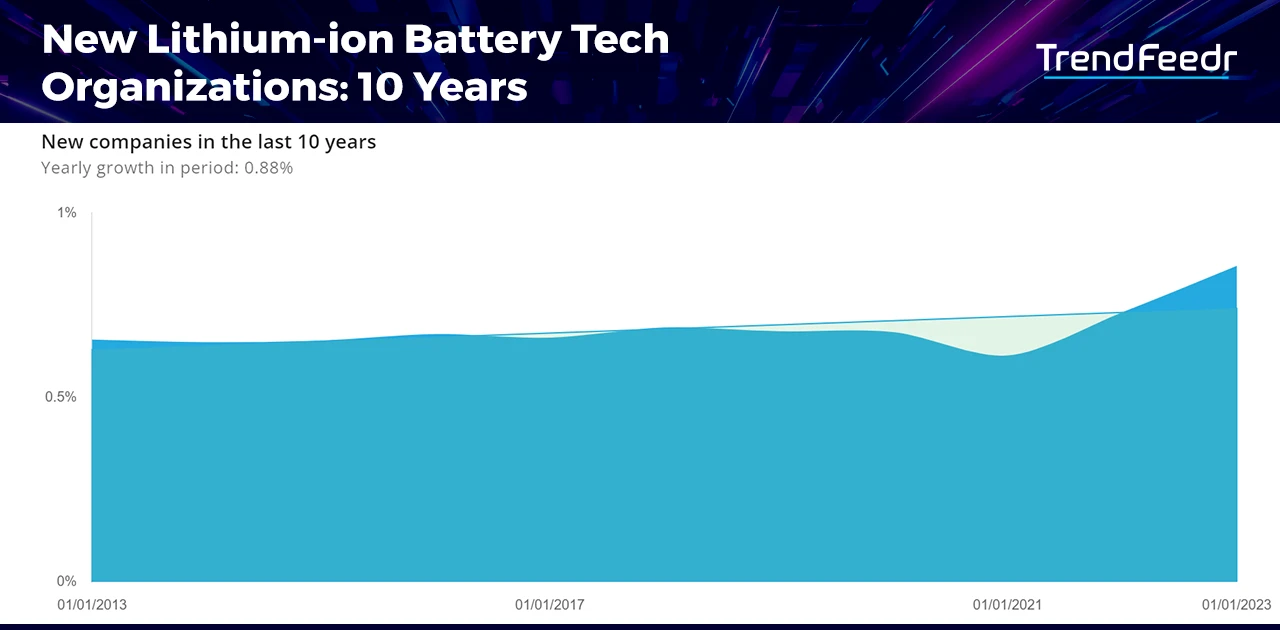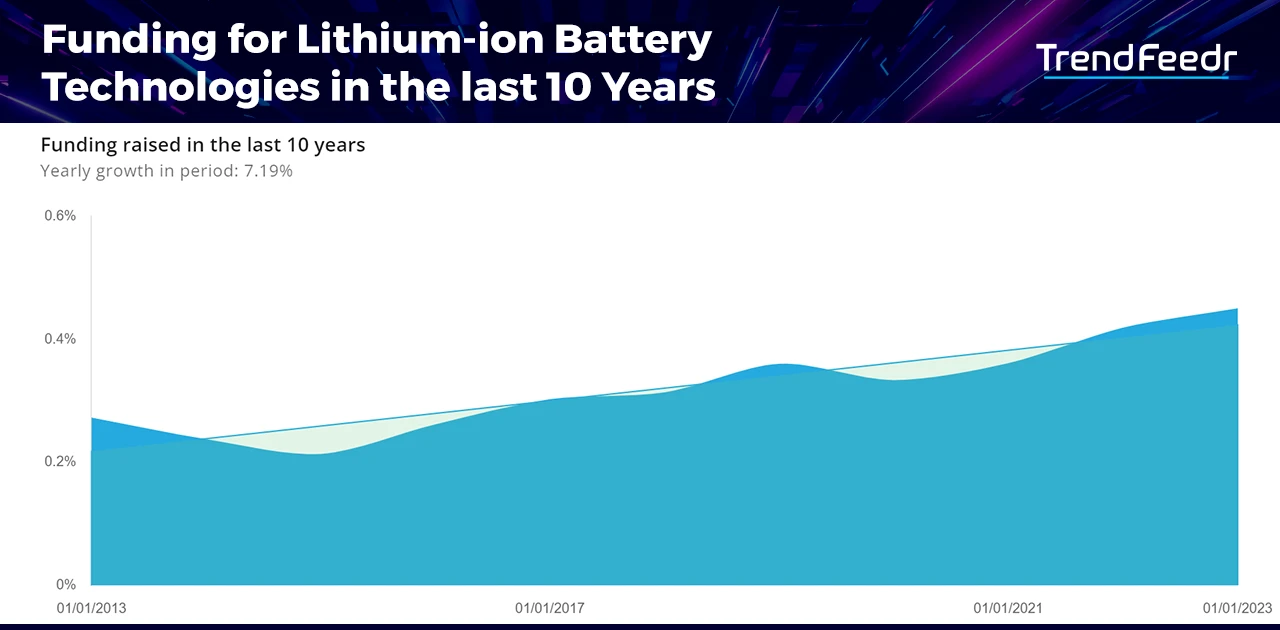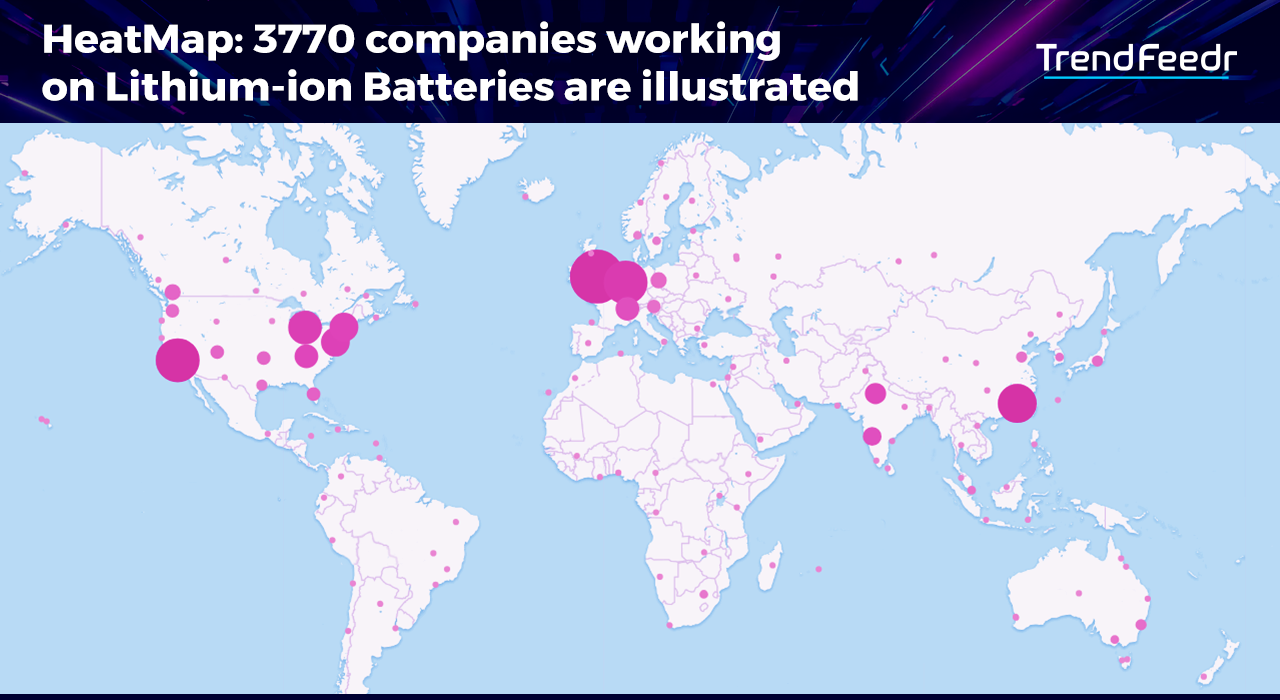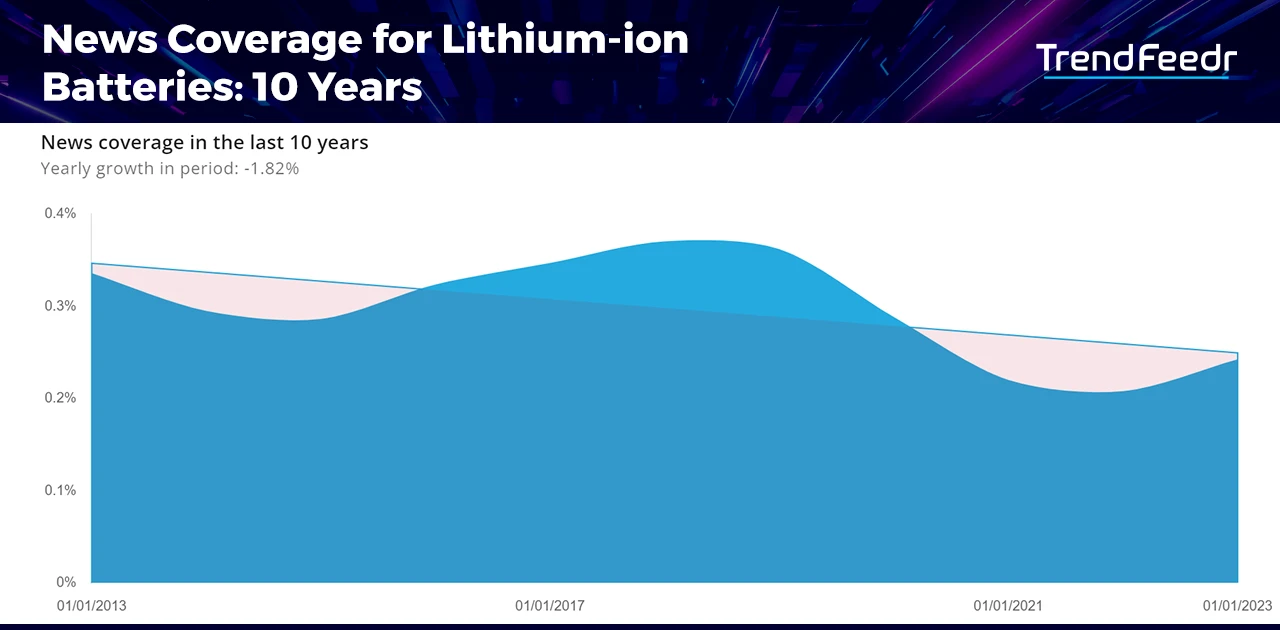The lithium-ion battery is at the forefront of the energy storage revolution, powering our smartphones, laptops, electric vehicles (EVs), off-grid systems, and more. The emerging lithium-ion battery trends enable higher gravimetric and volumetric energy densities. New battery technologies using the lithium-ion configuration are lithium-iron-phosphate (LFP) batteries, li-polymer batteries, lithium thionyl chloride batteries, and silicon anode batteries They allow electric cars to run for hundreds of miles on a single charge as well as improve the overall energy-storing capacity.
Besides, lithium-ion batteries are essential for ensuring cleaner and more efficient transportation, powering renewable energy systems, and providing backup power during outages. By enabling renewable energy storage and reducing reliance on fossil fuels, lithium-ion batteries play a crucial role in decarbonization across industries. They also have a low rate of self-discharge when kept idle, making them an excellent choice for applications where prolonged periods of inactivity are expected.
Key Takeaways
- Evolving Trend: Lithium-ion battery ranks in the top 3% of 20K+ trends covered by TrendFeedr, with an annual growth rate of 3.25%, a trend magnitude of 97.24%, and a trend maturity of 60.13%.
- Expansion in similar trends: Lithium-ion companies are also actively exploring related trends such as lithium-iron phosphate, li-polymer, lithium thionyl chloride, and silicon anode batteries.
- The increasing involvement of new organizations working with lithium-ion batteries witnessed 0.88% yearly growth over the last 10 years.
- Corporate & Investment Landscape: The total funding in battery technology is approximately $63.2B, with revenue estimated at $58.8B.
- Prominent backers such as the US Department of Energy, Public Institutions, and General Motors underscore the substantial financial support in the sector.
- Front-runners in lithium-ion battery integration include the US, China, India, Japan, and Canada, with key cities including Shenzhen, Noida, Dongguan, Hong Kong, and Perth.
Table of Contents
- Understanding Lithium-Ion Battery Trends
- Lithium-ion Battery Trend Performance Analysis
- Emerging Trends in Lithium-ion Batteries
- How Lithium-ion Batteries Disrupt Industries
- Investments in Lithium-ion Battery Technologies
- Geographical Activity: Mapping the Global Adoption of Lithium-ion Battery
- Future Outlook of Lithium-ion Batteries
In this data-driven analysis, we explore the latest trends in lithium-ion batteries, including advancements in lithium-iron phosphate, li-polymer, lithium thionyl chloride, and silicon anode batteries. Also, we deep dive into the major industries impacted by lithium-ion batteries, funding for Li-ion battery technologies, and more.
We leverage TrendFeedr, our all-in-one trend intelligence platform, for this in-depth research. TrendFeedr identifies future industry and tech trends via advanced, proprietary algorithms. With a focus on trend discovery, clustering, and analysis, the AI-powered platform screens thousands of trends each week to track their development and curate actionable insights.
Out of all 20,000+ trends and technologies that TrendFeedr covers, lithium-ion batteries have had a notable influence. Here’s why:
- Lithium-ion batteries are highly versatile and rank among the top 3% globally. Their ability to be manufactured in various shapes and sizes makes them adaptable to a wide range of applications.
- This trend has a high magnitude of 97.24%, indicating significant and continuous investments in manufacturing infrastructure, research, and development to make lithium-ion batteries more affordable and efficient.
- The popularity of lithium-ion batteries has surged due to their high energy density, decreased production costs, increased demand for portable electronics and EVs, as well as the adoption of renewable energy sources.
Understanding Lithium-Ion Battery Trends
How did Lithium-ion Battery trends evolve?
Over the past decade, the battery industry has seen rapid changes, including lithium-ion battery innovations to improve energy density and charging speeds. There have also been advances in making these batteries safer and longer-lasting. As demand for lithium-ion batteries rises, there is a growing emphasis on making their production and recycling processes sustainable. The latest trends highlight progress in battery recycling methodologies and a shift towards more environmentally friendly materials.
Why is Lithium-ion Battery in demand?
From electronics, toys, handheld power tools, and small appliances to large equipment and electric vehicles, lithium-ion batteries have wide use cases. They are favored for their lightweight design, high energy efficiency, and ability to retain their charge over extended periods.
How are Lithium-ion Batteries changing Today’s Technology?
Businesses across various industries leverage lithium-ion batteries for diverse applications. In the manufacturing sector, they power automated machinery while they enable electric transportation in logistics. In the tech industry, they fuel cutting-edge devices. The versatility and efficiency of lithium-ion batteries make them an invaluable asset for modern businesses, driving innovation and growth.
For instance, smart grids are transforming the energy infrastructure by utilizing lithium-ion battery systems to store renewable energy, paving the way for a more sustainable future. These advanced systems efficiently store and distribute energy from renewable sources. This reduces the reliance on non-renewable energy sources and promotes a cleaner, more sustainable energy infrastructure.
Lithium-ion Battery Trend Performance Analysis
Presenting our lithium-ion battery trend card – your concise guide to the latest developments, benchmarks, and applications driving the future of portable power.
Our trend card provides an in-depth look at the lithium-ion battery landscape. It includes information on leading organizations and human resources in the field. You’ll also learn about financial aspects such as funding and revenue from major investors supporting lithium-ion batteries. Further, our analysis examines the impact of lithium-ion batteries on various industries, countries, and cities, giving you a global view of their development.
Lithium-ion batteries are experiencing a steady annual growth rate of 3.25% and have a strong trend magnitude of 97.24%. It indicates they are attracting significant investments in research and development, as well as support from environmental and policy initiatives. It also ranks in the top 500 out of all 20K+ trends, with a trend maturity of 60.13%. This trend is in its prime phase of development, poised for further expansion, commercialization, and innovation.
Looking for all trends related to lithium-ion battery technologies?
Recent Global Lithium-ion Battery Trends
Companies working with lithium-ion batteries frequently branch out into other emerging trends. This exclusive overview offers a glimpse into their wide-ranging contributions to associated battery trends.
1. Lithium-Iron Phosphate or LFP) Batteries
- LFP batteries offer safety and long cycle life, which makes them an ideal choice for large-scale applications such as electric vehicles and renewable energy storage.
- A total of 788 organizations are currently involved in LFP technology, with a combined funding of $6.5 billion.
- The total manpower committed to LFP stands at an impressive 63,500.
2. Li-Polymer Batteries
- Li-polymer batteries are lightweight and have a flexible form, making them well-suited for portable electronics and certain aerospace applications.
- 89 organizations are currently working on Li-polymer batteries, with a combined investment of $178.5 million.
- The total manpower dedicated to this technology is approximately 8,245.
3. Lithium Thionyl Chloride Batteries
- Lithium thionyl chloride batteries have high energy density and long shelf life. They are suitable for applications where long-term reliability is crucial.
- Currently, 41 organizations are exploring this technology, with a combined funding of $22.4 million.
- The manpower dedicated to this technology stands at 8,248.
4. Silicon Anode Batteries
- Silicon anodes offer higher energy density compared to traditional graphite anodes in lithium-ion batteries, extending battery life and capacity.
- There are currently 113 organizations exploring silicon anode technology that have a combined funding of $4.6 billion.
- The manpower dedicated to this trend is approximately 6,897.
The companies involved in the lithium-ion battery industry are not only focusing on their core technology but also actively exploring related trends. This diverse engagement is a reflection of the dynamic and interconnected nature of the energy storage landscape.
How Lithium-ion Batteries Disrupt Industries
Several sectors are utilizing lithium-ion batteries, with their impact being especially significant in certain areas. Below is a list of some of these sectors.
Public Transportation
Lithium-ion batteries have emerged as a game-changing technology in public transportation. They are being utilized in electric buses and trains, providing cities around the world with efficient and eco-friendly transportation. By reducing emissions, these batteries are playing a crucial role in promoting sustainable urban development.
Telecommunications
In the telecommunications industry, lithium-ion batteries have become an essential component of backup power systems in telecom towers. These batteries ensure uninterrupted service and reliability in communication networks, providing a dependable source of power in the event of an outage and in remote locations. As such, lithium-ion batteries are playing a vital role in maintaining the integrity of the global communication infrastructure.
Heavy Industries
Industrial lithium-ion batteries transform the operational dynamics of heavy machinery across sectors such as mining, construction, and manufacturing. These batteries, with their sustainable and energy-efficient capabilities, emerge as a better alternative to conventional fuel sources. Their high power output on demand and resilience under strenuous conditions make lithium-ion batteries an optimal choice for energizing heavy-duty machinery. This contributes to a reduction in emissions and also enhances operational efficiency within these industries.
Agriculture
The agriculture sector leverages lithium-ion batteries to power electric tractors and farming equipment. These electric machines produce zero emissions at the point of use and operate more quietly than their diesel counterparts. The innovative Li-ion battery technologies have the potential to reduce reliance on fossil fuels and promote environmentally friendly practices.
Military and Defense
Lithium-ion batteries are being utilized in military and defense to power equipment and vehicles, as well as to provide energy storage in remote bases. Unmanned aerial vehicles (UAVs) and unmanned ground vehicles (UGVs) benefit from their lightweight design. They also get the necessary power for extended operations without the need for frequent recharging.
In summary, trends in lithium-ion batteries are revolutionizing industries by providing a sustainable, efficient, and versatile power source. Their high energy density, decreased production costs, and increased demand have made them a popular choice for a wide range of industrial and commercial applications. They are enabling innovative technologies from mobile robots to electric tractors and, in turn, ensuring a sustainable future.
What brands make Lithium-ion Batteries?
The lithium-ion battery has become a focal point for numerous organizations due to its potential and significance. Approximately, 3770 organizations are actively researching and developing new technologies -with a focus on improving the performance, safety, and cost-effectiveness of these batteries.
Over the past decade, the annual growth rate of new organizations working with lithium-ion batteries has been increasing by 0.88%. It indicates that this sector has experienced steady growth, highlighting the potential for business and drawing the attention of new players.
Here’s the highlight of the top 5 new lithium-ion battery organizations founded in the last 5 years:
- Re-Lithium – A lithium-ion battery company that collects and recycles spent batteries to maximize battery life and material recovery, making its production and use sustainable.
- Silib – A developer of silicon anodes designed to improve the capacity of lithium-ion batteries.
- e-TRNL Energy – A company developing a new-generation Li-ion battery cell technology that uses less power, eliminating cell heating and enabling fast charging without cell degradation.
- Atlantic Energy Storage – An energy storage company that develops a Li-ion battery system platform to reduce carbon-based fuels and optimize energy consumption
- Circunomics – An operator of a data-based battery marketplace for second-life and lithium-ion battery recycling.
Investments in Lithium-ion Battery Technologies (2024)
In terms of financial backing, the total funding dedicated to advances in lithium-ion batteries is positioned within the top 5% bracket of all 20K+ trends covered by TrendFeedr, our trend intelligence tool.
The U.S. Department of Energy (DOE) has demonstrated a strong commitment to advancing battery technology, investing $2.6 billion across 17 organizations. Significant investments include $700 million in Ioneer and $480 million in Ascend Elements.
Public institutions have also shown considerable interest in this sector, investing $2.3 billion across 25 organizations. Hubei Zhongyi Technology and Pylontech are among the top beneficiaries, receiving $416.8 million and $332.6 million, respectively. These investments reflect the growing public interest in advancing battery technologies and their applications.
In the private sector, General Motors, a leader in the automotive industry, has allocated $954.4 million for investments in battery technology. Their portfolio includes 6 organizations, with LithiumAmericas receiving the largest share of $650 million and Aspen Aerogels obtaining $100 million.
Likewise, the lithium-ion battery trend boasts significant investor interest, with a unique investor count that stands in the top 5% of all trends.
The line chart depicts the upward trajectory of lithium-ion battery funding raised over the past decade, with a consistent yearly growth rate of 7.19%. This robust increase suggests rising market demand for lithium-ion batteries and highlights the escalating financial interest and investment in this technology.
In addition to financial growth, the lithium-ion battery industry is also expanding in terms of human capital. With a total manpower of 479.7K, an average of 171, and a median of 21, the industry is fostering talent and innovation at various levels. Employee yearly growth figures further support this trend, with a total of 31.7K new hires, an average of 13, and a median of 3.
Lithium-ion Battery Investment Landscape
Based on data from TrendFeedr on Lithium-Ion Batteries, the total funding stands at $63.2B, with a maximum of $3.2B, an average of $83.6M, and a median of $4.3M. These figures demonstrate the strong financial commitment from various stakeholders.
Further, the estimated total revenue stands at $58.8B, with a maximum of $1.1B, an average of $21.6M, and a median of $2.7M. This diverse range includes a mix of industry giants, mid-sized companies, and lithium-ion battery startups.
The funding landscape for lithium-ion batteries is diverse, with the top 5 funding types being Grants, Early-Stage VC / Series A, Seed, Venture Round, and Later-Stage VC / Series C. Among these, 6.1% of lithium-ion battery companies have secured a total of 401 grants.
Geographical Activity: Mapping the Global Adoption of Lithium-ion Battery Technologies
The map below illustrates the global distribution of the 3770 lithium-ion battery companies, showcasing the widespread interest and investment in this field.
Interested to explore all 3700+ lithium-ion battery technology companies?
The United States, with its innovative ability, is a pioneer in lithium-ion battery research and implementation. India’s drive for electric vehicles has quickly made it a significant player. China leads in both development and production, perpetually prevailing in electronics and EV markets. Japan’s historical strength in technology guarantees its continued relevance, while Canada’s dedication to clean energy propels its progress in lithium-ion battery tech.
On a city-level analysis, Shenzhen and Dongguan in China continue to maintain their dominance in lithium-ion battery innovation and production. Noida in India is quickly rising as an important center for lithium-ion battery technology, mirroring India’s increasing focus on clean energy solutions. Hong Kong offers a combination of strong research initiatives and commercial ventures, making it a critical player in the Asian battery landscape. Perth, from the Australian continent, demonstrates growing interest and investments in contemporary battery solutions.
Media Coverage of Lithium-ion Batteries Experiences a Stable Growth
Over the past decade, lithium-ion battery coverage has remained relatively stable. However, a slight decrease in its relative share was observed between 2014 and 2016, before it recovered in 2017. With breakthroughs in energy storage and innovations in electric transportation, lithium-ion batteries continue to receive media attention.
Further, the lithium-ion battery trend has experienced significant growth in publication propagation, ranking within the top 5% among all 20K+ trends. The number of articles related to lithium-ion batteries has surged too, placing the topic in the top 5%, with 43196 articles published in the period from 2005 to 2023.
What is the Future Outlook of Lithium-ion Batteries?
Based on the current trajectory and available data, we have gathered some insights and predictions on the future of lithium-ion batteries. Here is what we can expect from this field in the coming years
1. Increased Adoption of Electric Vehicles
The surge in EV adoption has led to heightened demand for lithium batteries. With the global push towards sustainability, these batteries are becoming increasingly prevalent in electric cars, buses, and commercial vehicles. The adoption of lithium-ion batteries in EVs is likely to continue as more and more consumers and businesses opt for environmentally friendly transportation options.
2. Integration with Energy Grids
Accommodating renewable energy sources in the grid is difficult as they are decentralized and intermittent sources. Lithium-ion batteries enable energy utilities to leverage advanced energy storage systems (ESS) to revolutionize energy management and distribution. By incorporating lithium-ion batteries into smart grids, it is possible to optimize energy usage and reduce waste. This allows for greater efficiency and flexibility in grid operations.
3. Improvements in Battery Safety and Reliability
As lithium batteries become more prevalent in various applications, concerns arise regarding their safety, especially in high-stress environments or during malfunctions. Ongoing research and development efforts are focused on addressing these concerns, with a particular emphasis on preventing overheating and improving battery lifespan. These efforts are expected to result in the production of safer and more reliable lithium-ion batteries.
4. Diversification into New Industries
Lithium-ion batteries revolutionize industries such as space exploration, deep-sea operations, and other specialized fields that demand reliable and efficient energy storage. In the future, exploring new and innovative applications for this technology will unlock new opportunities for growth and development.
5. Potential Competition from Alternative Technologies
As the demand for energy storage solutions continues to grow, new and innovative technologies are emerging that will challenge or even surpass the capabilities of lithium-ion batteries. Ongoing research into alternative technologies, such as solid-state batteries and fuel cells, may provide new competition or complementary solutions in the long term.
Stay Ahead of the Curve in the Lithium-Ion Battery Industry
The lithium-ion battery industry is experiencing rapid transformation, making it essential to stay informed about the latest breakthroughs. The future of lithium-ion technology will include innovative solutions from researchers, manufacturers, and other industry leaders to drive us toward a new era of improved energy storage.
To succeed in this dynamic landscape, it is crucial to adapt your business strategies and activities to align with the evolving lithium-ion battery market and maintain a competitive advantage. This can be achieved by delving into specialized journals on lithium-ion batteries and engaging in forums discussing energy storage. Even better, following industry experts, and attending exhibitions and conferences that are focused on battery technology. Further, utilizing platforms such as TrendFeedr, designed for tracking industry trends, can also prove invaluable.
Keeping track of the latest developments in lithium-ion battery trends will allow you to remain at the forefront of energy storage solutions, driving sustainability and efficiency.

